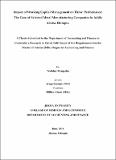| dc.description.abstract | Management of working capital refers to management of current assets and current liabilities. Firms may have an optimal level of working capital that maximizes their value. Prior evidence has determined the relationship between working capital and performance. Thus, this study examined the impact of working capital management on firms' performance by using audited financial statements of a sample of 11 metal manufacturing private limited companies in Addis Ababa, Ethiopia for the period of 2008 to 2012. The performance was measured in terms of profitability by return on total assets, and return on investment capital as dependent financial performance (profitability) variables. The working capital was determined by the Cash conversion period, Accounts receivable period, inventory conversion period and accounts payable period are used as independent working capital variables. Moreover, the traditional measures, current ratio are used as liquidity indicators, firm size as measured by logarithm of sales, firm growth rate as measured by change in annual sales and financial leverage as control variables. The data was analyzed using SPSS (version 20.0), estimation equation by both correlation analysis and pooled panel data regression models of cross-sectional and time series data were used for analysis. Results indicate that longer accounts receivable and inventory holding periods are associated with lower profitability. The results also show that there exists significant negative relationship between cash conversion cycle and profitability measures of the sampled firms. No significant relationship between cash conversion cycle, account receivable period, inventory conversion period and account payable period with return on investment capital has been observed. On the other hand, findings show that a highly significant negative relationship between account receivable period, inventory conversion period and account payable period with return on asset. The results conclude that cash conversion cycle has significant negative relationship with return on asset. In general paying suppliers longer and collecting payments from customers earlier, and keeping product in stock less time, are all associated with an increase in the firms performance. Managers, therefore, can increase firms‟ profitability by improving the performance of management of working capital components. | en_GB |


